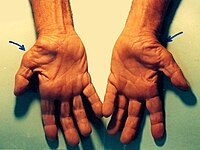
Photo from wikipedia
Nerve Conduction Studies for Carpal Tunnel Syndrome: Gold Standard or Unnecessary Evil? To the Editor: Dr Fowler, in his recent guest editorial,1 espouses the popular orthopedic view that a clinical… Click to show full abstract
Nerve Conduction Studies for Carpal Tunnel Syndrome: Gold Standard or Unnecessary Evil? To the Editor: Dr Fowler, in his recent guest editorial,1 espouses the popular orthopedic view that a clinical diagnosis of carpal tunnel syndrome (CTS) based only on history and examination is both definitive and sufficient for subsequent management of the patient. He contends that, in the future, electrodiagnosis will be compared with medieval practices such as bloodletting as a treatment. I would first remind Dr Fowler that, were it not for the advent of electrodiagnostic testing, surgeons would still be resecting first ribs of patients with the clinical syndrome of CTS. However, now that the pathophysiology of the disorder is well understood, it is incumbent on those of us who practice electrophysiology to demonstrate that our tests do contribute to patient management. First, to address the role of nerve conduction studies (NCSs) in the diagnosis of CTS. Nerve conduction studies do not absolutely define the presence of CTS. All medical investigations have false-positive and false-negative rates, and it has been amply demonstrated from Bayes theorem that when the prior probability of CTS is either very high or very low, then neither a normal nor an abnormal NCS result is likely to alter the diagnosis.2 However, there are significant numbers of patients in whom the diagnosis is less clear, and these are not confined to those in whom there is other confounding pathology. In such cases, the NCS result does significantly increase or decrease the probability that the patient has CTS. Arguing over the exact incidence of false-positive and false-negative results is sterile in the absence of a true gold standard for comparison, and values can be cherry picked from the literature to support any view. There is an equal lack of quality data on the false-positive and false-negative rates of clinical diagnosis, but only the arrogant believe clinical diagnosis to be 100% reliable. However, in most cases, NCSs are not “diagnostic” but a source of information about the patient that is not available from any other source. Using the results rationally requires a detailed understanding of the relationship among NCS results, examination findings, and treatment outcomes. Outcomes of carpal tunnel surgery are clearly better if the nerve is decompressed before marked axonal loss has occurred. Clinically, severe CTS with a poorer prognosis is marked by thenar wasting and weakness3 and fixed sensory deficit.4 If NCS results are reported using a modern grading scheme, it can be seen that very severe NCS abnormalities are also associated with poorer outcomes.5 It turns out that clinical signs of severe median nerve damage are strongly correlated with grade 5 and grade 6 NCS results. Unfortunately, by the time these clinical and neurophysiological findings are evident, it is too late. Pressure on the median nerve should be alleviated before these features appear. Nerve conduction studies are currently the only tool that can quantitatively reveal the deterioration in median nerve function that takes place as CTS evolves from grade 1 to grade 4, as patients in these grades are clinically indistinguishable. If it were simply the case that all patients with diagnosed CTS needed surgery, then this would not matter greatly. However, it is obvious from the literature that not all cases do require surgery,6 and surgery has not only medical and social costs but also a complication rate that is not insignificant. If it is reserved for patients in NCS grade 3 and above and for those in whom conservative measures have failed, then overall costs of treating CTS and surgery rates fall while patient outcomes improve. All of this is without considering the supplementary roles of NCSs in detecting other unsuspected pathology and aiding in the assessment of patients who have not gained the desired result from surgery. Finally, needle electromyography is not necessary to measure the severity of CTS. This can be done perfectly well with NCSs alone, reducing both the cost and the discomfort of electrodiagnosis. Jeremy D. P. Bland, MB ChB Canterbury, Kent, United Kingdom The author has no relevant financial relationships to disclose.
Journal Title: Orthopedics
Year Published: 2017
Link to full text (if available)
Share on Social Media: Sign Up to like & get
recommendations!